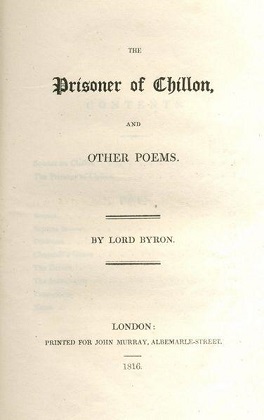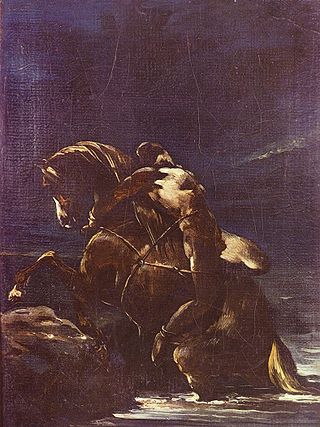
Kubla Khan is a poem written by Samuel Taylor Coleridge, completed in 1797 and published in 1816. It is sometimes given the subtitles "A Vision in a Dream" and "A Fragment." According to Coleridge's preface to Kubla Khan, the poem was composed one night after he experienced an opium-influenced dream after reading a work describing Shangdu, the summer capital of the Mongol-led Yuan dynasty of China founded by Kublai Khan. Upon waking, he set about writing lines of poetry that came to him from the dream until he was interrupted by "a person from Porlock". The poem could not be completed according to its original 200–300 line plan as the interruption caused him to forget the lines. He left it unpublished and kept it for private readings for his friends until 1816 when, at the prompting of Lord Byron, it was published.

Romanticism was an artistic and intellectual movement that originated in Europe towards the end of the 18th century. In most parts of Europe it was at its peak from approximately 1800 to 1850. Romanticism was characterized by its emphasis on emotion and individualism, clandestine literature, and paganism. Romantic thinkers idealized nature, were often suspicious of industrialization and rationalism, and frequently glorified the Middle Ages by depicting them in moralistic, idealized forms. Romanticism was partly a reaction to the Industrial Revolution, and the prevailing ideology of the Age of Enlightenment, especially the scientific rationalization of Nature. It was embodied most strongly in the visual arts, music, and literature; it also had a major impact on historiography, education, chess, social sciences and the natural sciences. It had a significant and complex effect on politics: Romantic thinking influenced conservatism, liberalism, radicalism and nationalism.

The Byronic hero is a variant of the Romantic hero as a type of character, named after the English Romantic poet Lord Byron. Both Byron's own persona as well as characters from his writings are considered to provide defining features to the character type.

Susanna Blamire was an English Romantic poet, sometimes known as 'The Muse of Cumberland' because many of her poems represent rural life in the county and, therefore, provide a valuable contradistinction to those amongst the poems of William Wordsworth that regard the same subject, in addition to those of the other Lake Poets, especially those of Samuel Taylor Coleridge, and in addition to those of Lord Byron, on whose The Prisoner of Chillon her works may have had an influence. Blamire composed much of her poetry outside, sat beside a stream in her garden at Thackwood. She also played the guitar and the flageolet, both of which she used in the process of the composition of her poetry.

Childe Harold's Pilgrimage is a long narrative poem in four parts written by Lord Byron. The poem was published between 1812 and 1818. Dedicated to "Ianthe", it describes the travels and reflections of a world-weary young man, who is disillusioned with a life of pleasure and revelry and looks for distraction in foreign lands. In a wider sense, it is an expression of the melancholy and disillusionment felt by a generation weary of the wars of the post-Revolutionary and Napoleonic eras. The title comes from the term childe, a medieval title for a young man who was a candidate for knighthood.
"The Destruction of Sennacherib" is a poem by Lord Byron first published in 1815 in his Hebrew Melodies. The poem is based on the biblical account of the historical Assyrian siege of Jerusalem in 701 BC by Assyrian king Sennacherib, as described in 2 Kings 18–19, Isaiah 36–37. The rhythm of the poem has a feel of the beat of a galloping horse's hooves as the Assyrian rides into battle.

In English literature, Don Juan, written from 1819 to 1824 by the English poet Lord Byron, is a satirical, epic poem which portrays the Spanish folk legend of Don Juan, not as a womaniser as the character is historically portrayed, but as a victim easily seduced by women. As genre literature, Don Juan is an epic poem, written in ottava rima and presented in sixteen cantos. Lord Byron derived the character of Don Juan from traditional Spanish folk legends, however the story was very much his own. Upon publication in 1819, cantos I and II were widely criticized as immoral because Byron had so freely ridiculed the social subjects and public figures of his time. At his death in 1824, Lord Byron had completed sixteen of seventeen cantos, whilst canto XVII remained unfinished.
Western literature, also known as European literature, is the literature written in the context of Western culture in the languages of Europe, and is shaped by the periods in which they were conceived, with each period containing prominent western authors, poets, and pieces of literature.

Konrad Wallenrod is an 1828 narrative poem, in Polish, by Adam Mickiewicz, set in the 14th-century Grand Duchy of Lithuania.
Nicolo or Nicolas Giraud was a friend of English Romantic poet Lord Byron. The two met in 1809 while Byron was staying in Athens. Giraud, who at that time of their relationship was a fourteen-year-old majordomo and then student at the Capuchin monastery in Athens, reportedly taught Byron Italian, and was his travel companion in Greece. Byron paid for Giraud's education and left him £7,000 in his will. Years after they parted company, Byron changed his will to exclude Giraud. Other than his involvement with Byron, little is known of Giraud's life.

Mazeppa is a narrative poem written by the English Romantic poet Lord Byron in 1819. It is based on a popular legend about the early life of Ivan Mazepa (1639–1709), who later became Hetman of Ukraine. Byron's poem was immediately translated into French, where it inspired a series of works in various art forms. The cultural legacy of Mazeppa was revitalised with the independence of Ukraine in 1991.

The Prisoner of Chillon is a 392-line narrative poem by Lord Byron. Written in 1816, it chronicles the imprisonment of a Genevois monk, François Bonivard, from 1532 to 1536.
Nationality words link to articles with information on the nation's poetry or literature.
The Romantic hero is a literary archetype referring to a character that rejects established norms and conventions, has been rejected by society, and has themselves at the center of their own existence. The Romantic hero is often the protagonist in a literary work, and the primary focus is on the character's thoughts rather than their actions.

George Gordon Byron, 6th Baron Byron, known simply as Lord Byron, was an English romantic poet and peer. He was one of the leading figures of the Romantic movement, and has been regarded as among the greatest of English poets. Among his best-known works are the lengthy narratives Don Juan and Childe Harold's Pilgrimage; many of his shorter lyrics in Hebrew Melodies also became popular.
"The Gypsies" is a narrative poem in 569 lines by Alexander Pushkin, originally written in Russian in 1824 and first published in 1827. The last of Pushkin's four 'Southern Poems' written during his exile in the south of the Russian Empire, The Gypsies is also considered to be the most mature of these Southern poems, and has been praised for originality and its engagement with psychological and moral issues. The poem has inspired at least eighteen operas and several ballets.

Percy Bysshe Shelley was one of the major English Romantic poets. A radical in his poetry as well as in his political and social views, Shelley did not achieve fame during his lifetime, but recognition of his achievements in poetry grew steadily following his death and he became an important influence on subsequent generations of poets including Robert Browning, Algernon Charles Swinburne, Thomas Hardy, and W. B. Yeats. American literary critic Harold Bloom describes him as "a superb craftsman, a lyric poet without rival, and surely one of the most advanced sceptical intellects ever to write a poem."
Opium and Romanticism are well-connected subjects, as readers of Romantic poetry often come into contact with literary criticisms about the influence of opium on its works. The idea that opium has had a direct effect on works of romantic poetry is still under debate; however, the literary criticism that has emerged throughout the years suggests very compelling ideas about opium and its impact on Romantic texts. Usually these criticisms tend to focus on poets such as Samuel Taylor Coleridge, Thomas De Quincey and George Crabbe.

Romanticism was an artistic, literary, and intellectual movement that originated in Europe toward the end of the 18th century. Scholars regard the publishing of William Wordsworth's and Samuel Coleridge's Lyrical Ballads in 1798 as probably the beginning of the movement, and the crowning of Queen Victoria in 1837 as its end. Romanticism arrived in other parts of the English-speaking world later; in the United States, it arrived around 1820.

Ivan Mazepa (1639–1709) was a significant figure in the history of Ukraine. One story about him says that as a young man, he was caught in flagrante with a noblewoman, whose husband punished him by tying him naked to a wild horse and setting them free; eventually he reached the Cossacks and became their military leader. This legend caught the attention of the English poet Lord Byron, whose Mazeppa (1819) brought the events to wider attention. His narrative poem inspired many paintings, particularly by French Romantics, which in turn stimulated musical compositions, stage plays, more poems, and so on. New life was breathed into the equestrian tale when it was transposed to the American Wild West. With the independence of Ukraine in 1991, the figure of Mazepa is once again on the international stage.














